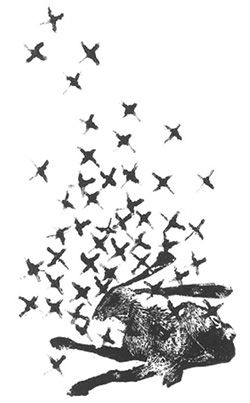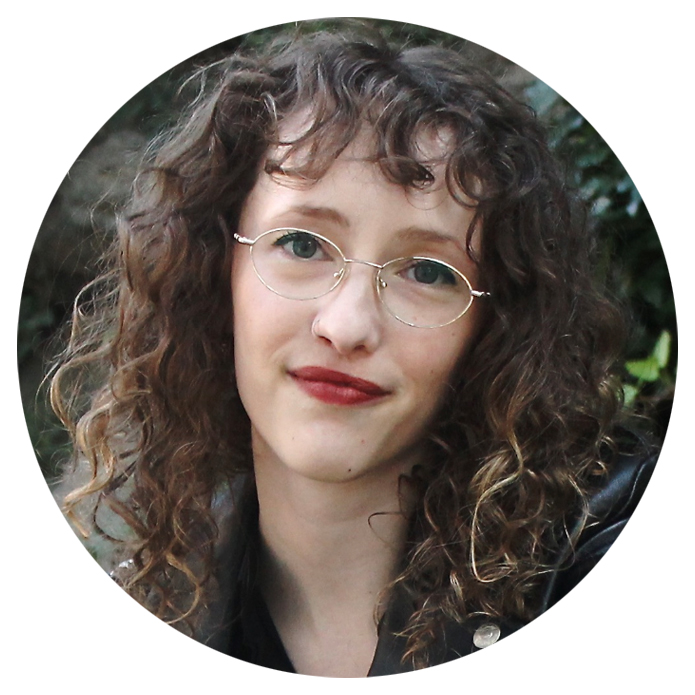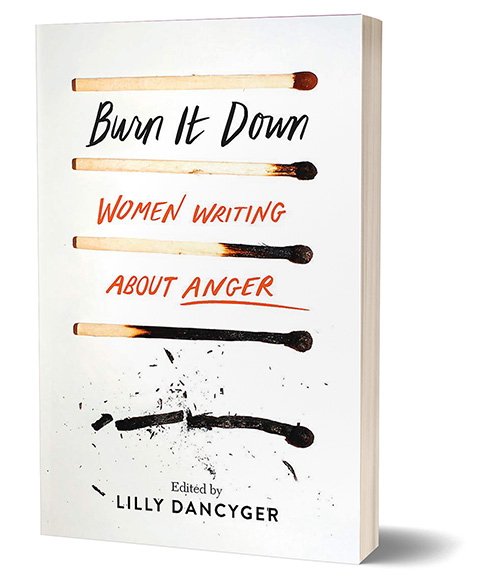
or this month’s “On Submission With...” column, we have an experienced literary journal editor and book editor, as well as a memoir author, accomplished essayist, classroom instructor, and editor-for-hire for projects ranging from full manuscripts to individual essays. Please give a warm welcome to Lilly Dancyger, author, essayist, and editor!
Before diving into our Q&A, let’s take a peek at Lilly’s deep writing and editing background:

Lilly Dancyger is a contributing editor at Catapult, and assistant editor at Barrelhouse Books. She’s the editor of Burn It Down, a critically acclaimed anthology of essays on women’s anger from Seal Press, named one of the “most recommended books of the season” by Literary Hub. Additionally, Lilly authored Negative Space, which published in May 2021 with Santa Fe Writers Project. Negative Space is a reported and illustrated memoir that was selected by Carmen Maria Machado as a winner of the Santa Fe Writers Project Literary Awards in 2019. Lilly is also the founder and host of Memoir Monday, a weekly newsletter and quarterly reading series co-curated by Narratively, The Rumpus, Guernica, Granta, Literary Hub, and Catapult. Her writing has been published by Longreads, The Washington Post, Glamour, Playboy, Rolling Stone, and more. She lives in New York City.

WOW: Welcome, Lilly! It’s so good to chat with you again, after we worked together last year when I hired you for a “big-picture” edit for my memoir manuscript. Readers, you can see the editorial services and tiers Lilly offers at her website, along with links to her published essays. We’ll discuss her two books later in the interview.
I kept seeing your name on Twitter several years back, and after following your tweets for some time and reading the great testimonials you’ve received for your services, I reached out when I felt my manuscript was ready for an objective pair of eyes. I’m glad I did, because your big-picture feedback was exactly what I needed to zero in on my themes.
Lilly: Thanks so much for inviting me to be part of this very cool series—and I’m so glad to hear that my editorial notes were useful in honing your memoir draft!
WOW: Let’s start with your developmental editing experience, and from there we can move to your role as an editor with Barrelhouse Books. Although most in our audience will be familiar with the various types of editing services out there, I’m including this link since it’s nice to have a quick reference at hand.
Lilly, I love your background in essay writing and memoir, which was a big reason I felt my manuscript would be in capable hands. My first question, therefore, is this: Do you find yourself taking on more projects that are memoirs or CNF essays, or do you also work with fiction writers?
Lilly: I work almost exclusively with memoirists and essayists, though I’ve edited the occasional novel or short story as well. My experience as a writer is entirely in the nonfiction sphere, as well as my magazine and small press editing experience, so that’s where I have the most expertise—but there are some elements of good storytelling that transcend genre. Depending on what kind of feedback a fiction writer is looking for, I’ll tell them honestly whether I’m equipped to help them or not. I’ve turned away some fiction projects because the writer was looking for something specific that felt outside my skillset. But with memoir I know all the ins and outs of the genre, different craft techniques, market trends, and so forth. So that’s where I’m most comfortable.
WOW: To fill in the backstory for our readers on our collaboration last year, I sent Lilly what at the time was a 100,000-word manuscript. It was my first professional edit. I knew my manuscript was bloated since many memoirs are closer to 80,000 words. You helped me see which parts were bogging it down. Readers, I was able to cut 40,000 words that were not serving me! It felt scary. The best piece of advice you gave me was to add more interiority. I’m happy to say I did after I cut the writing that was not needed for the writing that was needed. I’m now at 80,000 words, with quite a bit more interiority and focus.
Can you share with our readers the elements that make a memoir manuscript meaningful and full of interiority? And, why is interiority needed between scenes? I remember from your feedback to me that it’s to keep readers invested in the protagonist and the outcome, and to drive a story forward, correct?
Lilly: Interiority is what makes a memoir more than just an account of what happened. Reflection is where the writer makes meaning out of their experiences and invites the reader into their personal growth and the impact of the experiences they’re recounting. And yes, letting readers into how the events that are unfolding on the page impacted you, to how you felt at each pivotal moment, makes them feel more like they’re moving through the experience with you, rather than just seeing it happen from the outside. This creates emotional investment.
I think you need both for a good memoir—a compelling narrative, and insightful reflection, though the balance will differ from project to project. Some popular memoirs are more action-driven, while others are more interior, so it just depends on the story you want to tell and your writing style. I think a lot of writers have internalized the old “show don’t tell advice” a little too completely. Yes, we need to be immersed in vivid, active scenes, but sometimes we also need you to tell us what you’re thinking and feeling in order to really make us care about you as a narrator.
WOW: Yes, I think we’ve all seen how “showing” gets the love most of the time, but I agree that “telling” is just as important in the right places, as it also move us quickly through large spans of time or so that we don’t lose momentum in minutiae. So, what have you found to be an effective ratio of showing versus telling? Any tips for us to keep in mind as we’re drafting?
Lilly: There’s definitely no one-size-fits-all ratio that will work for every story, so I’m going to give the answer that I know readers don’t like hearing when it comes to “writing how to’s:” It depends! A good rule of thumb I often offer my clients and students is to give an event an amount of page space that’s proportionate to its significance in the story. Slow down and write really vivid, detailed, immersive scenes for the most important, pivotal moments; and speed up time, or summarize, for the in-between stuff that’s necessary for context but isn’t what you’ve really come to the page to talk about.

“Interiority is what makes a memoir more than just an account of what happened. Reflection is where the writer makes meaning out of their experiences ... [and] makes readers feel more like they’re moving through the experience with you, rather than just seeing it happen from the outside.”
WOW: What do you look for in editorial projects that are “must haves” to keep readers engaged?
Lilly: Like I said above, I think you need both a compelling story and something interesting to say about that story. Telling me something wild that happened to you isn’t going to be enough to keep me interested, but neither is a meditation that’s totally ungrounded in action and scene. It’s all about finding the balance between action and reflection, and making sure that the writer has something interesting to offer in both of those areas.
WOW: When should writers start thinking about getting professional editing feedback?
Lilly: Only after they’ve pushed it as far as they can on their own. I often see people jumping to get feedback too soon, which is at best a waste of money, and at worst can actually hinder the creative process. Writers are so often in a hurry (I’m totally guilty of this myself, too), but writing a book takes time! And most of that time should be spent between you and the page. Nobody else can solve the big questions of what you want to say and how you want to say it. So, my advice would be to finish a complete draft, and then do at least one full revision on your own, without any prying eyes or outside suggestions influencing you, and then think about trading pages (or full manuscripts) with peers for feedback for the next couple of revisions, and then hire an editor. But don’t bother hiring an editor to read your very first complete draft.
WOW: That sounds like a sensible timeline. Do you have any guidance on how to make the collaboration between writers and developmental editors more effective? What can writers keep in mind or do, when sending their work? Is a list of feedback questions for the editor helpful to send with the project?
Lilly: I’m always open to receiving specific questions from editing clients, but I don’t read them until after I’ve done my first read-through of the manuscript. I find it most effective to come to the manuscript without any preconceived notions of what might be working or not working, so that those things can jump out to me on their own. I do my first pass and take notes, and then I compare those notes to any questions the writer may have sent. Often I will have already answered them, but if not I’ll address them directly after the fact. But the most important thing is to get the manuscript as close to done as you can on your own before sending it to me (or any other editor). It’s not worth your money to have me send you a bunch of suggestions that you were already planning to do but hadn’t gotten to yet.
WOW: Can you share with us examples of clients you’ve worked with who have either gone on to publish books, or essays and short stories?
Lilly: I don’t keep track of all the essay links, although I guess I should! But clients have placed pieces I edited in The New York Times, The Washington Post, Longreads, The Rumpus, Catapult, and tons of other outlets over the years. As for books, I know of at least three clients who recently signed with agents for manuscripts I worked with them on, but publishing moves so slowly that I’m not sure any of the books have actually come out yet. I’ve only been doing this for about four years, which is not that long in the publishing world!
WOW: Has being an editor made you approach the page differently with your own writing?
Lilly: Definitely! It’s made me more aware of certain tendencies. I’ll often catch myself doing something that I’ve pushed clients not to do, and then I know to correct it. It’s hard to read my own writing with an editor’s eye, but that’s the goal during revision, and I’m sometimes able to trick myself and read my work as if someone else wrote it. It’s also made me less precious about cutting or making big changes, because I see how often substantial cuts or rewrites are necessary in other people’s work. When I suggest cuts or rewrites for other people, it’s not because the work is bad or the writer is bad, it’s just part of the process—so I try to remember that for myself as well.

WOW: OK, tell us about your role with Barrelhouse Books. How did you start working with them? Are you an acquisitions editor? Walk us through your primary responsibilities.
Lilly: I presented at a Barrelhouse Conversations and Connections conference a few years ago (which is excellent, by the way!), and got to chatting with the nonfiction books editor, Mike Ingram. He mentioned that he was considering finding someone to help him manage the nonfiction acquisitions, and I volunteered! We work together closely through every stage of the process—from selecting titles to acquire, to developmental editing, line editing, proofreading and production, and publicity and marketing. So, I do a little bit of everything.
WOW: What do you most enjoy about your role with Barrelhouse Books? On the flip side, what are the challenges?
Lilly: I think my favorite part might be sending the offer email saying, “We want to publish your book!” I know what a slog the submissions process can be, and what it feels like to be so desperate for an acceptance, so being able to bring that joy to another writer is awesome. And just being able to pull a project that really excites me out of the slush pile and say, “Yes, this should be a book,” and then make that happen. It’s a dream, really! The hardest part is time management. It’s a volunteer, part-time position, so I have to balance my editorial responsibilities at Barrelhouse with my freelance editing and teaching, as well as my own writing, and at the moment with promoting my memoir, which is very time consuming.

WOW: You edited the anthology, Burn It Down, in 2019. How was that experience working with a cross-section of women writers? Did you choose the featured essays, and did the pieces require edits or was everything ready to roll? How long did the project take, beginning to end, and what prompted this collection?
Lilly: Putting an anthology together was incredibly challenging, but equally rewarding. Yes, I solicited and curated all of the essays, and worked with the writers to develop and polish them. Seal Press approached me in the spring of 2018 and Burn It Down came out in the fall of 2019, so it took about a year and a half from start to finish. The idea for an anthology on women’s anger was developed in-house at the press, and they tapped me to edit it. I go into more detail about the process in this round-table conversation I recently curated for The Rumpus, about the process of editing and promoting anthologies.

WOW: Love the round-table discussion in The Rumpus! It’s so revealing to get a behind-the-scenes look at what goes into editing an anthology. Alright, so you must be incredibly excited that your memoir, Negative Space, just published! I love the cover art. Is that a jackrabbit, and jacks? What’s the significance of the cover art, and how did your memoir come into the world?
Lilly: I am! This project was 11 years in the making (remember what I said about how writing a book takes time?), so I’m thrilled to see it finally on its way out into the world. The cover is a woodcut made by my father--it’s a rabbit and X’s. It’s part of a series of prints and sculptures he made for my mother after they broke up for the first time, that were about loving her.
The memoir is largely about my father’s art (which is reproduced throughout the book) so I always knew the cover image would have to be one of his pieces. In the book, I use his artwork as a guide to piece together a truer version of the story of his life, looking beyond the mythologized version of him I’d been mourning since his early death when I was 12 years old. He was a complicated man; a heroin addict, and not always the most considerate husband or the most present father. I wanted to mourn a more complete version of him as I entered adulthood and tried to figure out how my grief was going to fit into my adult life. The saga of how this book came into the world is a long one, but I wrote about it in detail for Electric Literature, if anyone is interested!
WOW: Your experience that you write about in Electric Literature with that first publisher is a cautionary tale, no doubt! Yet, it’s refreshing and heartening to read that you stuck to your belief in your story and as a result your memoir is entering the world as the fully realized vision you always saw. Bravo!
OK, final question: Music or podcasts, while on a walk or run? Any favorites you want to share?
Lilly: Music, always. I’m not a podcast person—I either find them annoying, or my mind wanders and I realize I haven’t heard the last ten minutes of whatever was said! I don’t really have any recommendations to make, since my music taste has pretty much stayed the same over the last 20 years. But I’ve been listening to this playlist I made called “Angry Feminist Ghosts” on repeat lately. (The title came from a joke when I realized that most of my favorite music sounds like it was made by angry feminist ghosts. It’s kind of true.)
My thanks to author, essayist, and editor, Lilly Dancyger, for chatting with me. I’m grateful to Lilly for her careful reading and big-picture suggestions for my memoir manuscript. It absolutely helped me look at it in a fresh light. If you’re interested in working with Lilly, take a look at the editorial services she offers and get in touch.

Ann Kathryn Kelly lives and writes in New Hampshire’s Seacoast region. She’s an editor with Barren Magazine, a columnist with WOW! Women on Writing, and she works in the technology sector. Ann leads writing workshops for a nonprofit that offers therapeutic arts programming to people living with brain injury. Her essays have appeared in a number of literary journals. https://annkkelly.com/.